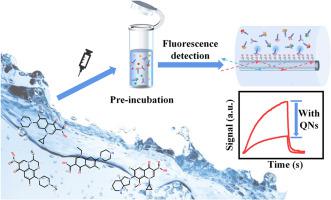当前位置:
X-MOL 学术
›
Anal. Chim. Acta
›
论文详情
Our official English website, www.x-mol.net, welcomes your feedback! (Note: you will need to create a separate account there.)
A group-targeting biosensor for sensitive and rapid detection of quinolones in water samples
Analytica Chimica Acta ( IF 6.2 ) Pub Date : 2024-03-13 , DOI: 10.1016/j.aca.2024.342475 Bohan Wang , Lanhua Liu , Haopeng Zhang , Zhiqiang Wang , Kang Chen , Bo Wu , Limin Hu , Xiaohong Zhou , Lanlan Liu
Analytica Chimica Acta ( IF 6.2 ) Pub Date : 2024-03-13 , DOI: 10.1016/j.aca.2024.342475 Bohan Wang , Lanhua Liu , Haopeng Zhang , Zhiqiang Wang , Kang Chen , Bo Wu , Limin Hu , Xiaohong Zhou , Lanlan Liu

|
Quinolones (QNs) widely exist in the environment due to their wide range of applications and poor metabolic properties, resulting in the generation and spread of resistance genes, posing a potential threat to human health. Traditional analytical methods cannot detect all broad ranges of QNs simultaneously. The development of facile, efficient and reliable method for quantification and assessment of the total QNs is a long-lasting challenge. We hereby provide a simple, sensitive and instantaneous group-targeting biosensor for the detection of total QNs in environmental water samples. The biosensor is based on a group-specific antibodies with high affinity against QNs. Fluorescent labeled antibodies bound to the coated antigen modified on the surface of the transducer, and excited by the evanescent waves. The detected fluorescent signal is inversely proportional to the QNs concentration. This biosensor exhibited excellent performance with detection limits lower than 0.15 μg L for all five QNs variants, and even lower than 0.075 μg L for ciprofloxacin (CIP) and ofloxacin (OFL). Environmental water samples can be detected after simple pretreatment, and all detection steps can be completed in 10 min. The transducer has a high regenerative capacity and shows no significant signal degradation after two hundred detection cycles. The recoveries of QNs in a variety of wastewater range from 105 to 119%, confirming its application potential in the measurement of total QNs in reality. The biosensor can realize rapid and sensitive detection of total QNs in water samples by simple pretreatment, which overcomes the disadvantage of the traditional methods that require complex pretreatment and time-consuming, and pave the groundwork for expansive development centered around this technology.
中文翻译:

一种用于灵敏快速检测水样中喹诺酮类药物的群体靶向生物传感器
喹诺酮类药物(QNs)因其用途广泛、代谢特性差而广泛存在于环境中,导致耐药基因的产生和传播,对人类健康构成潜在威胁。传统的分析方法无法同时检测所有广泛的 QN 范围。开发简便、高效和可靠的方法来量化和评估总 QN 是一个长期的挑战。我们特此提供一种简单、灵敏、瞬时的群体靶向生物传感器,用于检测环境水样中的总 QN。该生物传感器基于对 QN 具有高亲和力的群体特异性抗体。荧光标记的抗体与传感器表面修饰的包被抗原结合,并被倏逝波激发。检测到的荧光信号与 QNs 浓度成反比。该生物传感器表现出优异的性能,所有五种 QN 变体的检测限均低于 0.15 μg/L,环丙沙星 (CIP) 和氧氟沙星 (OFL) 的检测限甚至低于 0.075 μg/L。环境水样经过简单的预处理即可检测,所有检测步骤可在10分钟内完成。该传感器具有很高的再生能力,并且在 200 个检测周期后没有表现出明显的信号衰减。各种废水中QNs的回收率在105%至119%之间,证实了其在现实中总QNs测量中的应用潜力。该生物传感器通过简单的预处理即可实现水样中总QNs的快速、灵敏检测,克服了传统方法预处理复杂、耗时长的缺点,为围绕该技术的广泛发展奠定了基础。
更新日期:2024-03-13
中文翻译:

一种用于灵敏快速检测水样中喹诺酮类药物的群体靶向生物传感器
喹诺酮类药物(QNs)因其用途广泛、代谢特性差而广泛存在于环境中,导致耐药基因的产生和传播,对人类健康构成潜在威胁。传统的分析方法无法同时检测所有广泛的 QN 范围。开发简便、高效和可靠的方法来量化和评估总 QN 是一个长期的挑战。我们特此提供一种简单、灵敏、瞬时的群体靶向生物传感器,用于检测环境水样中的总 QN。该生物传感器基于对 QN 具有高亲和力的群体特异性抗体。荧光标记的抗体与传感器表面修饰的包被抗原结合,并被倏逝波激发。检测到的荧光信号与 QNs 浓度成反比。该生物传感器表现出优异的性能,所有五种 QN 变体的检测限均低于 0.15 μg/L,环丙沙星 (CIP) 和氧氟沙星 (OFL) 的检测限甚至低于 0.075 μg/L。环境水样经过简单的预处理即可检测,所有检测步骤可在10分钟内完成。该传感器具有很高的再生能力,并且在 200 个检测周期后没有表现出明显的信号衰减。各种废水中QNs的回收率在105%至119%之间,证实了其在现实中总QNs测量中的应用潜力。该生物传感器通过简单的预处理即可实现水样中总QNs的快速、灵敏检测,克服了传统方法预处理复杂、耗时长的缺点,为围绕该技术的广泛发展奠定了基础。



























 京公网安备 11010802027423号
京公网安备 11010802027423号